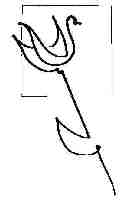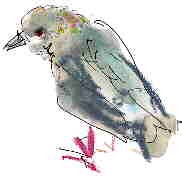|
Norman
Allan | ||||
 |
Dr. Norman Allan's Vol
8, No. 1, |  |
|
announcing
and,
a repeat of some old files (worth revisiting) ...
|
Dr.
Allan is now available
|
|
|
I
am now working with the ..* * * |
Inner
Arts Collective |
|
|
What differentiates
living matter from non-living stuff? Some have spoken of a "vital
energy", but was is that? Till recently a total mystery. I have written about this in an article titled "some thoughts on the substance of life (and the foundations of consciousness)" posted on me website. This is a difficult subject to understand and to explain, and I am not at all certain I have explained it well. I would welcome editorial feedback, so I would be grateful if you would read this article and comment - ask me to clarify anything there that is unclear. Thank you. |
Riverdale
Homeopathic
phone 416 928 9272
Its
been a while since I've sent out a "newsletter"
Dr.
Allan is now available
|
|
|
..* * *
|
they
say that advertising need repetition repetition
so with scant apologies ... |
|
|
Good
Vibrations/Salubrious
Oscillations I saw an article in June
'06 that vibrations, standing on a vibrating plate, can increase bone
and muscle mass! The vibrations used were 34 Hz (cycles per second)
through a distance of 50 micrometers (a hair's breadth) such that the
acceleration involved was a quarter of a gravity, and I wondered what
order of magnitude is this? Is it comparable to the vibrations we feel
in our bodies when we sing or chant? SCIENTIST GETS VIBES TO BUILD
BONES. "Device to help space travelers approved to treat sufferers of osteoporosis." The device is a machine that generates vibrations - vibration implies acceleration/deceleration, and is therefore somewhat like gravity - therefore in theory, and it seems in practice, good for maintenance of bone mass in zero gravity (it was designed for use in space). On earth, the article says, "a person who stands on [the platform of the vibration device] for 20 minutes a day can build bone density an average of 2 percent a year. ... By sending small vibrations through the body - moving about 50 micrometers (or the thickness of a few human hairs) up and down and repeating at a rate of 34 cycles per second - the platform triggers musculoskeletal stimulations that naturally occur... the vibrations from the platform are set to a frequency that [generates acceleration that] is one-third that of gravity... and is therefore safe." Other devices (exercise machines) which generate 4 to 15 gravities are dangerous, we are told. The thing that I find interesting here is that a relatively subtle vibration is having an appreciable (positive) effect on body metabolism and function. I am therefore wondering what the vibrational effects of chanting, OM, for instance, are? We'd need an engineer to tell us about the difference in order of magnitude between that devise and the vibrations that are set up in your body by, a) a rock band in a bar, b) by chanting, OM for instance. However, orders of magnitude might or might not be of relevance here. Subtle vibrations may be having physiological effects. One would have to look and see. Meanwhile, the safe course would be to do the chanting. It's bound to have salubrious effects at many levels (if not bone mass and muscle mass - muscles, that too was in the article). ("Salubrious" = health promoting - forgive the use of a relatively obscure word.) "Over all the bone density of the controlled group [the reporter has got this wrong - he means "experimental group" as compared to the control group] increased by 3 percent during a year, and muscle mass improved by 4 percent." |
appointments
available at Riverdale
Homeopathic
appointments
available at Riverdale
Homeopathic |
|
|
"Low Buzz May Give Mice
Better Bones and Less Fat" Dr. Rubin of the State University
of New York "put mice on a platform that buzzes at such a low frequency
that some people cannot even feel it.(I think the author means "amplitude".
The only frequency the article mentions in 90Hz, which (if loud enough)
is audible.) The mice stand there for 15 minutes a day, five days a
week. Afterward, they have 27% less fat than mice that did not stand
on the platform - and correspondingly more bone. ... |
|
|
|
* * *
|
||
| I recently read a newspaper article quoting a study that showed Gingko to be toxic in mice. Reading through the article I discover that the researcher were using 10,000 to 100,000 times the therapeutic dose! Hey guys, if you drink all the water in the swimming pool, it will kill you. |
take away: read
carefully, |
|
|
* * *
|
||
| You know, it's a good idea to come in for a checkup (discuss all those little concerns and see if there is something simple that can help) if not once a month, once a season or, failing that, once a year ... |
Dr.
Allan is now available
at 257 the Danforth and 1331 Danforth (by appointment) phone 416 928 9272 |
|
|
* * *
|
||
|
further
to my advertisements here: you don't need
to be ailing to benefit from alternative medicine. CranioSacral
Therapy, for instance, is one of the most relaxing things I know
of. Treat yourself. (Your "benefits" may cover it [as it falls
into the scope of chiropractic].)
|
||
|
phone 416 928 9272 |
||
|---|---|---|
|
* * * |
||
|
visit
Dr. Allan's home page at |
||
|
* * *
|
||
| . | ||
|
from former
newsletters:..
|
||
|
St Johnswort Hypericum perforatum St. Johnswort is a nervine relaxant (mild sedative), anti-depressant,
general vulnerary (wound healer), nervine vulnerary, astringent, and
styptic (stops bleeding). Cautions! Note though that 10% of people find St. Johnswort sedative
Contraindications: Michael Vertolli says that while he knows of no official contraindications he "would not recommend prolonged use of St. Johnswort during pregnancy."
St. Johnswort cause the production of an enzyme, PXR, which causes the production of a cytochrome P450 (which is a major detox vehicle) that gets rid of "xenobiotics"(i.e. unnatural chemicals): it increases the metabolism of the detox system. |
|
|---|---|
| * * * | |
|
My understanding is that apple seed contain "amygdalin"
(AKA"laetrile"), a very controversial substance found in higher
concentration in wild apricots. Many of us counter culture types have
believed that wild apricot seeds and apple seeds protect against cancer.
Apple seeds? Apricot seeds? I am not sure that this has
been well researched. One the one hand, as stated above, I've heard
many advocate the moderate ingestion of these seed (6 apricot seeds
I believe was the number per day, we would take at one sitting the 1970s
in our macrobiotic household). On the other hand, I just heard a story
{urban myth?} about someone who hoarded apple seed and then took an
enormous dose, a bottleful, and died (so the story went). Ah, but the orthodocs say that laetrile is useless, the other piece of the controversy, and hereby hangs a story worth telling... Ralph Moss graduate
in classics (or English - this is my memory of the story for a while
ago) and went to work for Sloan-Kettering (S-K) in 1972 as a publicist.
At S-K he met an old researcher, Japanese, who had done some work on
laetrile at S-K. The research showed that laetrile would stop the metastasis
(the spreading) of breast cancer in mice! |
Dr.
Allan is now available
at 257 the Danforth and 1331 Danforth (by appointment) phone 416 928 9272 |
| * * * | |
|
Fish Oil, Plant Omega 3s, and Cardiovascular Health The is some evidence that fish "omega 3"oils are beneficial to cardiovascular health. Less evidence that plant source "omega 3" has the same value. (Note: there are three types of "omega 3" or "n-3 fatty acids": two from fish - eicosapentaenoic acid (EPA) and docosahexaenoic acid (DHA) - and one from plant sources - a-linolenic acid (ALA) found in walnuts, flax seeds and chia seeds. Is there more (though controversial) evidence for fish (EPA and DHA) than for plant ALA because there's been more research? Probably. Wikipedia says, "The 18 carbon [ALA] has not been shown to have the same cardiovascular benefits as DHA or EPA." Note, they say "has not been shown to," and not "has been shown not to." One of the studies I've found (on-line) found that an experimental walnut diet lowered total cholesterol and LDL cholesterol concentrations, while a fish diet resulted in decreased serum triglyceride and increased HDL-cholesterol concentrations. So both are valuable and may complement each other. (Though another author says that there is no data on the potential therapeutic benefit of EPA, DHA, or ALA supplementation on those individuals who already consume a vegetarian diet.) So, there just hasn't been that much research and so many authors are hedging there bets: "Observational data suggest that diets rich in EPA, DHA, or ALA do reduce cardiovascular events, including myocardial infarction and sudden cardiac death; however, randomized controlled trial data are somewhat less clear;" and "…The evidence [for plant sources, alpha-linolenic acid] is not as compelling as for fish oil." I'm a cardiac patient, and I'm a vegetarian, and for now I'm just
eating a lot of flax (freshly ground), chia, and walnuts. |
flax 
|
 |

